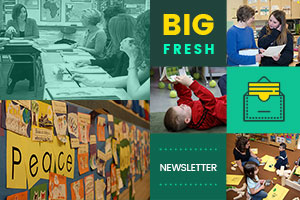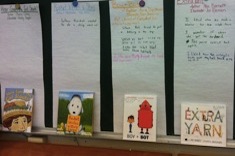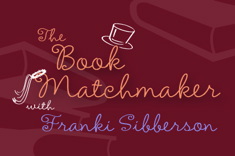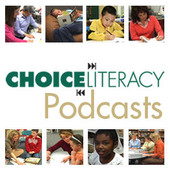Library
Choice Literacy Articles & Videos
The Choice Literacy library contains over 3,000 articles and 900 videos from 150+ contributors. Classic Classroom and Literacy Leadership subscribers have access to the entire library. Content is updated continuously, with five to six new features published each week.
Latest Content
Informational Snapshot Writing
Heather Rader finds web video is a powerful tool for scaffolding young writers as they produce informational texts.
Staying Child-Centered When You Work with Adults
Andie Cunningham shares challenges and practical strategies for how literacy leaders can stay child-centered.
Nourishment: Making Time and Space for Little Joys
We can’t forget the importance of being kind to ourselves. Ruth Ayres explains how small pleasures add up to big delights.
Teacher Vulnerability
Julie Johnson writes about renewal and staying centered during tough teaching times.
Mixing Information and Narratives
In this conference from a second-grade classroom, Sean Moore helps Mia flesh out her writing on friendship with examples.
Peer Conferring: The Modeling Phase
Amanda Adrian provides a framework, sample model lesson, and peer conferring guide for students to use as they learn how to respond to their classmates.
The Big Fresh November 3, 2012 Giving Too Much
Resources for teaching opinion and argumentative writing are the focus of this week’s Big Fresh.
Conferring for Conventions (Conventions Series Part 5)
Heather Rader gives examples of convention conferences in this final installment of the conventions series.
The Big Fresh October 27, 2012 Consider It Done
This week’s Big Fresh has a wealth of practical suggestions for working with reluctant writers.
Creating Anchor Charts with Multiple Classes
It’s a dilemma many middle school teachers face. How do you construct anchor charts with multiple groups of students, when only one chart will be hung in the room? Katherine Sokolowski explains how she ensures all classes have input and a “clean slate” in constructing charts.
Book Matchmaker: Read Aloud Versions of Old Favorites
Franki Sibberson presents some delightful versions of classic tales perfect for read alouds with youngsters.
Aligning the Common Core and Conventions Instruction (Conventions Series Part 4)
Heather Rader works with a team of intermediate teachers as they connect their plans for conventions instruction and the Common Core.
Reading as Reward
Principal Jennifer Schwanke finds herself on a mad dash to buy a baked potato for a struggling reader, and this is the moment that crystallizes for her everything that is wrong with most reading rewards (especially those involving food).
Formative Assessment: Wall Displays and Conversations in First Grade
Formative assessments are always a priority in classrooms. Cathy Mere explains how she uses a classroom wall display and conversations to highlight strong writing and help her first graders learn to assess improvements in their work.
The Apple Doesn’t Fall from the Tree: Nurturing Critical Thinking and Choice with Middle School Writers
Katie Baydo-Reed has to try, try, and try again to get high quality writing and thinking from her eighth graders, but the effort builds independence and reflection.
What Anchor Charts Are Essential?
Katherine Sokolowski considers what anchor charts are essential in her fifth-grade classroom, and where they work best for posting.
Ten Things Every Writer Needs to Know: A Podcast with Jeff Anderson
Jeff Anderson shares some insights from his latest book in this new podcast hosted by Franki Sibberson.
Conferring, Rereading, and Comprehension
Aimee Buckner confers with Brendan, who is rereading Hoot and needs some strategies for holding his thinking.
Make a Really BIG List
Big lists can be intimidating, especially when our to-do lists are long and never quite finished. Ruth Ayres explains the power of big lists in other contexts, especially writing, and how they might actually provide comfort and security when tackling big projects and ideas.
The Big Fresh October 20, 2012 Not Proficient
Big lists and minilessons are explored in this week’s Big Fresh.
Ten Classic Ideas That Still Work
Teachers are always on the hunt for something new, even as we cherish what works well year after year. Franki Sibberson lists the activities that have stood the test of time in her classroom.
Between Inquiry and Instruction (Conventions Series Part 3)
Heather Rader works with a team of intermediate teachers as they pore over student work together and analyze which conventions should be taught.
What Matters? Teaching Conventions Series
Heather Rader works with a team of intermediate teachers to ferret out what does and doesn’t work, based on research and experience.
Good News: Your Teacher is Calling
Heather Rader and Jennifer Taft share strategies for positive communication with parents.
The Big Fresh October 13, 2012 More More More
Parent communication is the focus of this week’s Big Fresh.
Book Memories
Jennifer Schwanke finds connections between her childhood, teaching, and school leadership in this heartwarming essay.
Opening Doors to Parents in Middle School
Gretchen Taylor finds middle school parents enjoy hearing about their child’s day — it’s just a matter of getting creative in dealing with the large number of families.
Writing Workshop: Preparing for Publication
Beth Lawson helps her fourth-grade students work through a checklist of items to prepare for publishing early in the fall.
The Big Fresh October 6, 2012 Future Literacy
This week we tackle grammar and conventions in the Big Fresh.
Concise, Conversational, and Consistent: Explaining the Work of Literacy Coaches
Heather Rader shares the language she uses to describe literacy coaching to others.
Browse Content By
Type
Category
- Assessment Tools
- Big Fresh Archives
- Booklists
- Choice Numeracy
- Classroom Design
- Common Core
- Community Building
- Conferring
- Content Literacy
- Digital Literacy
- English Language Learners
- Equity
- Family Relations
- Free Samples
- Guiding Groups
- Leadership
- Literacy Coaches
- Mentor Texts
- Minilessons
- New Teacher Mentors
- Podcasts
- Poetry
- Quote Collections
- Reading Strategies
- Self Care
- Struggling and Striving Learners
- Talking and Listening
- Teacher Study Groups
- Teaching Reading
- Teaching Writing
- Word Study and Vocabulary
Author
- Melissa Quimby
- Nawal Qarooni
- Gwen Blumberg
- Julie Cox
- The Lead Learners
- Hannah Tills
- Josie Stewart
- Ruth Metcalfe
- Mallory Messenger
- Becca Burk
- Jodie Bailey
- Vivian Chen
- Mary Brower
- Tiffany Abbott Fuller
- Stephanie Affinito
- Ruth Ayres
- Leigh Anne Eck
- Heather Fisher
- Shari Frost
- Julie Johnson
- Suzy Kaback
- Gigi McAllister
- Shirl McPhillips
- Melanie Meehan
- Cathy Mere
- Debbie Miller
- Tara Barnett and Kate Mills
- Tammy Mulligan
- Dana Murphy
- Bitsy Parks
- David Pittman
- Brenda Power
- Heather Rader
- Matt Renwick
- Mandy Robek
- Christy Rush-Levine
- Gretchen Schroeder
- Jen Schwanke
- Brian Sepe
- Katherine Sokolowski
- Stella Villalba
- Jennifer Vincent
Grade Level
Choice Literacy Membership
Articles
Get full access to all Choice Literacy article content
Videos
Get full access to all Choice Literacy video content
Courses
Access Choice Literacy course curriculum and training
























